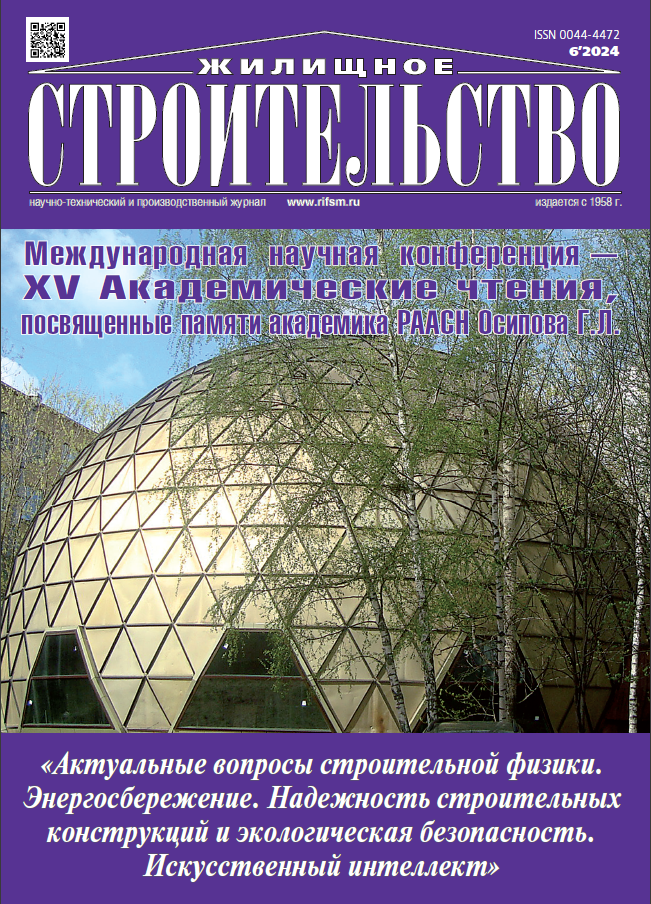Calculations of the Acoustic Efficiency of Noise Shields Based on the Numerical Solution of the Sound Diffraction Equation
- Авторлар: Antonov A.I.1,2, Gusev V.P.1, Ledenev V.I.1,2, Matveeva I.V.2, Shubin I.L.1
-
Мекемелер:
- Scientific-Research Institute of Building Physics of RAACS
- Tambov State Technical University
- Шығарылым: № 6 (2024)
- Беттер: 10-15
- Бөлім: Articles
- URL: https://gynecology.orscience.ru/0044-4472/article/view/634816
- DOI: https://doi.org/10.31659/0044-4472-2024-6-10-15
- ID: 634816
Дәйексөз келтіру
Аннотация
Currently, noise-proof wall screens are widely used in urban development to protect against traffic noise, noise from ventilation equipment installed on the roofs of buildings, as well as from other linear and point noise sources. To assess the acoustic efficiency of such screens at the design stage, a practical calculation method proposed by Z. Maekawa for semi-infinite screens of simple geometric shape is used. At the same time, screens of other complex geometric shapes are widely used in the practice of noise reduction by screening in the absence and presence of various technological openings and holes in them. In this case, the application of the calculation method proposed by Z. Maekava may give significant errors in assessing the acoustic efficiency of shielding. For such cases, the article suggests using a method based on the numerical solution of the sound diffraction equation. A computer program has been developed for the numerical solution of the Fresnel-Kirghoff equation and, based on it, the possibility of solving practical problems is shown. Using the program, the influence of openings and gaps available in screens of finite sizes on the acoustic efficiency of shielding is estimated. The proposed numerical method can be applied at the design stage of complex shaped flat noise shields.
Негізгі сөздер
Толық мәтін
Авторлар туралы
A. Antonov
Scientific-Research Institute of Building Physics of RAACS; Tambov State Technical University
Хат алмасуға жауапты Автор.
Email: aiant58@yandex.ru
Doctor of Technical Sciences
Ресей, 21, Lokomotivniy Driveway, Moscow, 127238; 106, Sovetskaya street, Tambov, 392000V. Gusev
Scientific-Research Institute of Building Physics of RAACS
Email: niisf@mail.ru
Doctor of Technical Sciences
Ресей, 21, Lokomotivniy Driveway, Moscow, 127238V. Ledenev
Scientific-Research Institute of Building Physics of RAACS; Tambov State Technical University
Email: ledvi46@yandex.ru
Doctor of Technical Sciences
Ресей, 21, Lokomotivniy Driveway, Moscow, 127238; 106, Sovetskaya street, Tambov, 392000I. Matveeva
Tambov State Technical University
Email: times02@yandex.ru
Candidate of Technical Sciences
Ресей, 106, Sovetskaya street, Tambov, 392000I. Shubin
Scientific-Research Institute of Building Physics of RAACS
Email: niisf@niisf.ru
Corresponding Member of the RAASN, Doctor of Technical Sciences
Ресей, 21, Lokomotivniy Driveway, Moscow, 127238Әдебиет тізімі
- Ivanov N.I., Svetlov V.V., Shashurin A.E. Noise reduction of stationary sources in residential buildings with technological noise-proof screens. Bezopasnost zhiznedeyatelnosty. 2018. No. 6 (210), pp. 16–22. (In Russian).
- Tyurina N.V. The use of acoustic screens to reduce noise in urban buildings. Protection of the population from increased noise exposure: Collection of reports of the V All-Russian Scientific and practical conference with international participation. St. Petersburg. 2015, pp. 97–112. (In Russian).
- Shubin I.L., Grebenkin A.M., Grebenkina E.V. Principles of designing noise-proof structures in an urban environment. Stroitelstvo I reconstructsia. 2017. No. 3 (71), pp. 101–106. (In Russian).
- Maekava Z. Recent Problems with Noise Barriers. Noise-93 Conference. St. Petersburg, Russia. 1993, pp. 125–131.
- Maekawa Z. Environmental acoustics update. Journal of the Acoustical Society of Japan (E). 1997. Vol. 18,3, pp. 97–107.
- Maekava Z. Noise Reduction by screens. Applied Acoustics. 1968. Vol. 1, pp. 157–173.
- Born M., Wolf E. Osnovy optiki [Fundamentals of optics]. Moscow: Nauka. 1973. 720 p.
- Kurze U.J. Noise reduction by barriers. J.A.S.A. 1974. Vol. 55. No. 3, pp. 504–518.
- Maekawa Z. Acoustic screens. In the book “Noise reduction in buildings and residential areas”. Edited by G.L. Osipov, E.Ya. Yudin. Moscow: Stroyizdat. 1987, pp. 426–448.
- Kuzminova S.A., Tupov V.B. The influence of technological openings on the acoustic efficiency of gas control point screens. Vestnik of the Moscow Power Engineering Institute. 2020. No. 3, pp. 81–88. (In Russian).
- Chuvirova S.A., Tupov V.B. The possibilities of acoustic screens to reduce the noise of hydraulic fracturing and gas pipelines after it. Protection from increased noise and vibrations: Collection of reports of the VII All-Russian scientific and practical conference with international participation. St. Petersburg. 2019, pp. 726–732. (In Russian).
- Tupov V.B. Features of using screens to reduce noise power equipment. Protection from increased noise and vibrations: Collection of reports of the VIII All-Russian scientific and practical conference with international participation. St. Petersburg. 2021, pp. 20–27. (In Russian).
- Tyurina N.V., Minina N.N. Noise reduction by acoustic screens installed on overpasses. Bezopasnost zhiznedeyatelnosty. 2012. No. 6, pp. 26–27. (In Russian).
- Gusev V.P., Ledenev V.I., Shubin I.L. Optimal environmental protection from noise exposure of HVAC systems equipment. Biosphernaya sovmestimost. 2014. No. 3 (7), pp. 32–42. (In Russian).
Қосымша файлдар
















